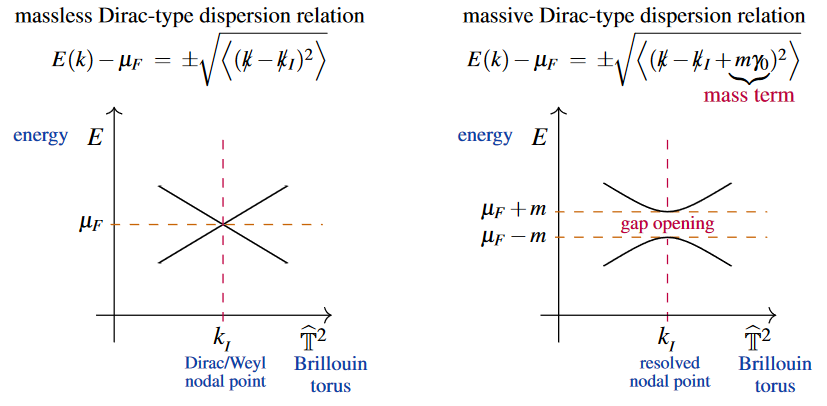nLab mass term
Context
Algebraic Quantum Field Theory
algebraic quantum field theory (perturbative, on curved spacetimes, homotopical)
Concepts
quantum mechanical system, quantum probability
interacting field quantization
Theorems
States and observables
Operator algebra
Local QFT
Perturbative QFT
Contents
Idea
In physics, a mass term is, quite generally, the summand in a Lagrangian density, Hamiltonian or equation of motion which expresses the mass of a given (quasi-)particle or field.
Often the terminology is used specifically for masses of spinors/Dirac fields, since here a mass term is subject to subtle constraints which may or may not exclude the mere existence of admissible mass terms.
Schematically, if a massless relativistic Dirac equation (here in Minkowski spacetime) is written in the form
where are the Clifford momentum-operator, then for a mass term addition
to lead to the required relativistic dispersion relation
one needs that the new Clifford-generator exists as an operator on the given Hilbert space of spinor such that it skew-commutes with all the Clifford momenta
This is the kind of condition that also appears in Karoubi‘s formlation of topological K-theory-classes as equivalence classes of Clifford modules (see Freed & Hopkins 2021, Thm. 9.63).
In this guise, mass terms for electron-excitations in semi-metals play a role in the K-theory classification of topological phases of matter (see below).
Examples
In particle physics
In particle physics the (non-)existence of mass terms for fermionic fundamental particles goes along with their characterization as Dirac spinors, Weyl spinors and Majorana spinors.
This plays a central role notably in discussion of the (still hypothetical) detailed nature of neutrinos.
In topological phases of matter
In solid state physics of crystals, electrons are typically well-approximated by the non-relativistic Dirac equation, but around nodal points in the Brillouin torus, where electron bands cross, the effective dispersion relation is again of form of a relativistic Dirac- or Weyl-equation (whence one speaks of Dirac points or Weyl points).

This phenomenon appears in particular in topological semi-metals, in which case the existence of a mass term, whose addition to the dispersion relation will remove the band crossing by “opening an energy gap”, is thought to signal the decay of the semi-metal-phase into a topological insulator-phase.
See for instance the example of the Haldane model.
Related concepts
References
A careful discussion of relativistic mass terms is in:
- Daniel S. Freed, Michael J. Hopkins, Reflection positivity and invertible topological phases, Geom. Topol. 25 (2021) 1165-1330 arXiv:1604.06527, doi:10.2140/gt.2021.25.1165
Discussion aimed at the description of topological semi-metal-phases in solid state physics includes:
-
Takahiro Morimoto and Akira Furusaki, Sec. V of: Topological classification with additional symmetries from Clifford algebras, Phys. Rev. B 88 (2013) 125129 (arXiv:1306.2505, doi:10.1103/PhysRevB.88.125129)
-
Ching-Kai Chiu, Andreas P. Schnyder, Section A.2 of: Classification of reflection-symmetry-protected topological semimetals and nodal superconductors, Phys. Rev. B 90 205136 (2014) doi:10.1103/PhysRevB.90.205136
-
Ching-Kai Chiu, Jeffrey C.Y. Teo, Andreas P. Schnyder, Shinsei Ryu, Section III.C of Classification of topological quantum matter with symmetries, Rev. Mod. Phys. 88 (2016) 035005 (arXiv:1505.03535, doi:10.1103/RevModPhys.88.035005)
See also discussion in the context of differential KO-theory:
- Kiyonori Gomi, Mayuko Yamashita, Differential KO-theory via gradations and mass terms [arXiv:2111.01377]
Some of the above material is taken from:
Last revised on February 16, 2023 at 07:41:55. See the history of this page for a list of all contributions to it.